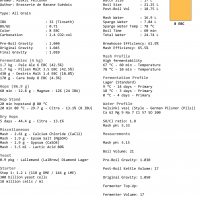Hi All,
I've been brewing with my Klarstein (Brewmonk, Hopcat etc.) about 6 months now and I just can't get to desired FG. The OG is usually pretty right but the desired ABV is always few points lower than expected.
Here's my previous lager which got stuck fermentation (abv 3%/5)

And here's my NEIPA receipe (abv usually 4-5%/6)

Here's the equipment profile.


I'm sparging pretty quickly so maybe that could be the problem. Also in NEIPA's the base malt percent is pretty low so could it be that there isn't enough sugars to fermen? Brewfather shows that my mash effiency is usually only 50-60%. I have tried with a starter and without it and feels like it won't matter wich one I go with.
I'm getting pretty frustrated here.
If you have any tips, it would be great! Thanks in advance!
I've been brewing with my Klarstein (Brewmonk, Hopcat etc.) about 6 months now and I just can't get to desired FG. The OG is usually pretty right but the desired ABV is always few points lower than expected.
Here's my previous lager which got stuck fermentation (abv 3%/5)

And here's my NEIPA receipe (abv usually 4-5%/6)

Here's the equipment profile.


I'm sparging pretty quickly so maybe that could be the problem. Also in NEIPA's the base malt percent is pretty low so could it be that there isn't enough sugars to fermen? Brewfather shows that my mash effiency is usually only 50-60%. I have tried with a starter and without it and feels like it won't matter wich one I go with.
I'm getting pretty frustrated here.
If you have any tips, it would be great! Thanks in advance!
























![Craft A Brew - Safale S-04 Dry Yeast - Fermentis - English Ale Dry Yeast - For English and American Ales and Hard Apple Ciders - Ingredients for Home Brewing - Beer Making Supplies - [1 Pack]](https://m.media-amazon.com/images/I/41fVGNh6JfL._SL500_.jpg)






















